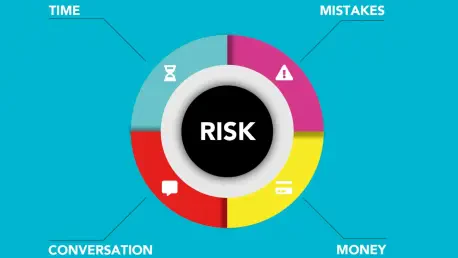Introducing Simon Glairy, a distinguished expert in risk management and Insurtech, whose expertise is highly sought after for his deep understanding of AI-driven risk assessment. As global businesses continuously adapt to unforeseen challenges, Simon provides crucial insights into the evolving landscape of corporate risk tolerance and resilience.
Can you explain how global disruptions over the past five years have changed corporate risk tolerance?
The past five years have been characterized by overlapping global disruptions, which have greatly transformed corporate risk tolerance. Companies have realized that large-scale crises are no longer rare events but rather likely occurrences, necessitating a strategic shift towards greater resilience and flexibility. This means adopting an adaptive mindset where they acknowledge that while prevention might be difficult, their real focus should be on preparation and response strategies.
What are the main factors driving the shift in risk strategies according to the Gallagher report?
The Gallagher report highlights several driving factors behind the shift in risk strategies, such as the challenges across supply chains, labor markets, and climate exposure. The report notes that nearly two-thirds of respondents find themselves in a riskier global context, prompting strategic pivots. Additionally, the acceleration of digital platforms has also pressured businesses to update their risk management frameworks.
How are insurers, brokers, and corporate risk managers responding to new threats in supply chains and labor markets?
Insurers, brokers, and corporate risk managers are increasingly prioritizing business continuity planning and investing in supply chain redundancy to counteract these new threats. They’re expanding supplier networks and sourcing strategies, with a noticeable shift towards domestic vendors. The adaptation also includes a diversified approach to risk financing and resilience-building investments, allowing organizations to better absorb and recover from potential supply chain interruptions.
In what ways are digital platforms and climate exposure influencing corporate risk management?
Digital platforms have significantly increased cybersecurity and AI-related risks, while climate exposure has brought climate risk management to the forefront, particularly in North America, where extreme weather events are frequent. Businesses are compelled to integrate climate considerations and digital vulnerability assessments into their overall risk management strategies to safeguard against these evolving threats.
What did Neil Hodgson mean by saying the mindset that “this won’t happen to us” is shifting among businesses?
Neil Hodgson points out that businesses are evolving from a place of complacency, where they assumed large-scale disasters weren’t probable, to a proactive stance. Companies are embracing the possibility of crises occurring and focusing instead on readiness. The question has shifted from “can it happen?” to “how are we prepared to handle it if it does?”
How are companies adapting their revenue models and market strategies in response to increased risk?
To combat increased risks, many companies are altering their revenue models or entering new markets. This involves diversification of their product lines, exploring new customer bases, and enhancing their agility to quickly address market changes. As per the study, 78% of firms indicated such modifications, underscoring a trend towards nimbleness and anticipation of future disruptions.
Could you elaborate on the “just-in-case” approach to inventory and sourcing? How prevalent is this strategy?
The “just-in-case” approach to inventory and sourcing has become notably prevalent, reflecting a strategic shift from the traditional “just-in-time” method. Companies are now more inclined to build inventory buffers and expand their supplier networks to mitigate the risk of supply chain disruptions. This approach ensures that businesses are not caught off-guard by sudden market shifts or supply chain hiccups.
What impact has the acceleration of digital operations had on risk categories like cybersecurity and AI?
The rapid acceleration of digital operations has expanded risk categories related to cybersecurity and AI. With more data being processed and stored digitally, the susceptibility to cyber threats has increased dramatically. Companies must implement stringent security measures and continually adapt to the evolving technological landscape, ensuring their digital fortresses are robust against new vulnerabilities.
How are organizations addressing people-related risks such as talent shortages and workforce wellness?
Organizations are increasingly recognizing people-related risks as enterprise-level threats. Issues like talent shortages and workforce wellness have become critical, prompting firms to invest in employee engagement and retention strategies. Efforts include innovative recruitment approaches, enhancing work-life balance, and focusing on wellness programs to foster a healthy, stable workforce.
In North America, how are extreme weather events influencing climate risk management?
Extreme weather events in North America have pushed climate risk management to the forefront. The increasing frequency and severity of events like hailstorms and wildfires demand greater scrutiny and adaptation efforts from insurers and businesses alike. This includes refining models for risk assessment, enhancing coverage options, and actively incorporating climate considerations into strategic planning.
How are natural catastrophe-related concerns affecting insurance pricing and scrutiny?
Natural catastrophe-related concerns are leading to heightened scrutiny and adjustments in insurance pricing. Insurers are becoming more vigilant in their assessments, often resulting in increased premiums and changes in policy terms to account for the growing prevalence and impact of these events. This heightened focus aims to ensure adequate coverage and risk mitigation.
What changes have taken place in risk financing and insurance strategies since the pandemic?
Since the pandemic, risk financing and insurance strategies have seen a remarkable transformation. Organizations have become more deliberate in their approach to insurance, with many increasing coverage levels and incorporating new types of policies. The pandemic underscored the importance of comprehensive coverage and a resilient approach to risk management, leading to strategic realignments.
How has the role of risk management personnel evolved in organizations since 2020?
Since 2020, the role of risk management personnel in organizations has evolved to become more integral and strategic. These roles are now pivotal in steering company-wide resilience initiatives, often expanding beyond traditional risk assessments to encompass enterprise-wide strategies in business continuity and crisis management. Their guidance is crucial in navigating the complexities of an interconnected business environment.
Can you discuss the significance of the finding that 81% of business leaders are more open to risk now than five years ago?
The finding that 81% of business leaders are more open to risk reflects a shift towards a proactive risk culture. With enhanced access to data and improved risk planning tools, leaders are empowered to take calculated risks in pursuit of growth opportunities. This openness signifies a readiness to embrace challenges with informed decision-making, fostering a dynamic business environment.
What role do data and analytics play in helping leaders respond to interconnected risk and people issues?
Data and analytics play a crucial role in equipping leaders to handle interconnected risks and people issues effectively. By leveraging comprehensive data insights, businesses can understand complex risk profiles, predict trends, and deploy effective mitigative strategies. Advanced analytics provide the clarity needed for informed decision-making, ensuring that leaders are not just reactive but strategic in their approach to risk management.
How do the identified megatrends of global trade, technological transformation, climate volatility, and workforce change create interdependent challenges for businesses?
These megatrends create interdependent challenges by intertwining economic activities, technological advancements, environmental changes, and workforce dynamics. Each aspect influences and is influenced by the others, necessitating an integrated approach. Businesses must navigate this complexity by aligning their strategies across these diverse areas to maintain resilience and capitalize on emerging opportunities effectively.
Could you share some insights from CEO Greg Case on the importance of integrated data and expertise in managing these challenges?
CEO Greg Case emphasizes the importance of integrating data and expertise to navigate the interlinked challenges businesses face. He suggests that a comprehensive understanding of these interconnected realms, backed by advanced analytics and expert insights, equips leaders to address what he terms “linked risk and people issues.” This approach underlines the necessity for holistic, informed decision-making in today’s volatile environment.
Do you have any advice for our readers?
Adaptability and foresight are crucial in today’s risk landscape. My advice would be to continuously acquire data and insights to stay ahead of potential disruptions. Building robust risk management frameworks and fostering a culture of proactive decision-making will empower businesses to not just survive but thrive amid uncertainty.









